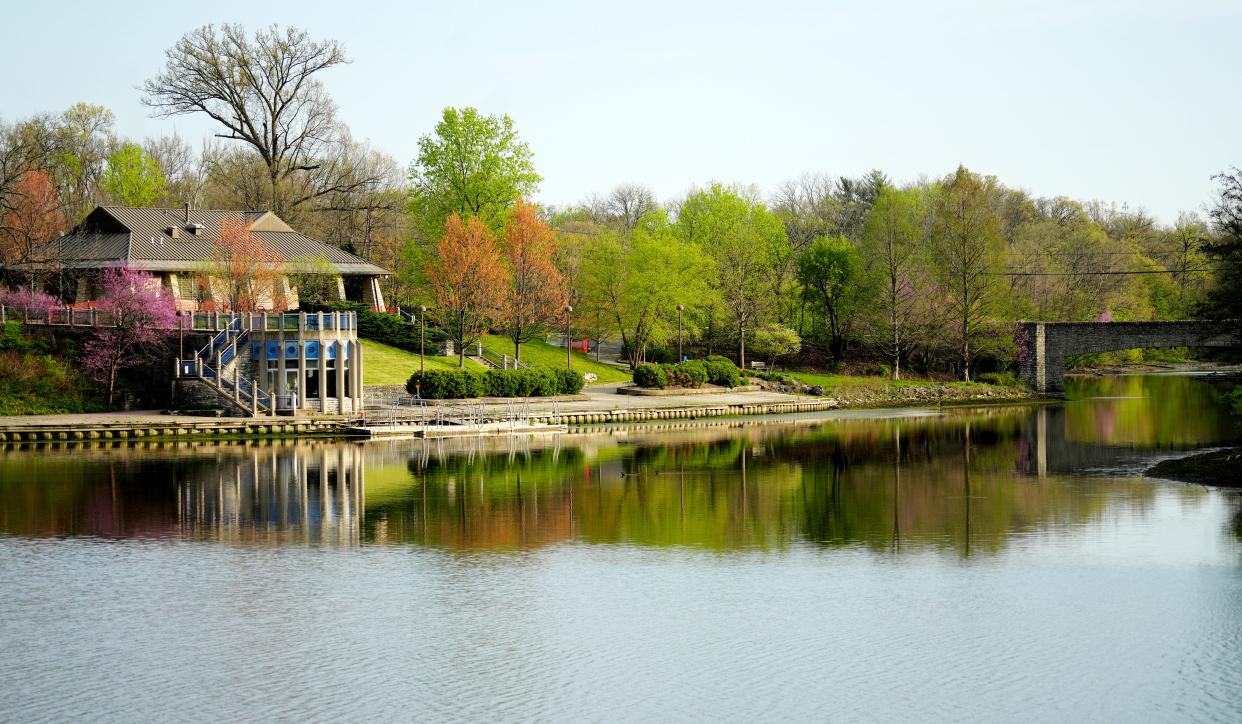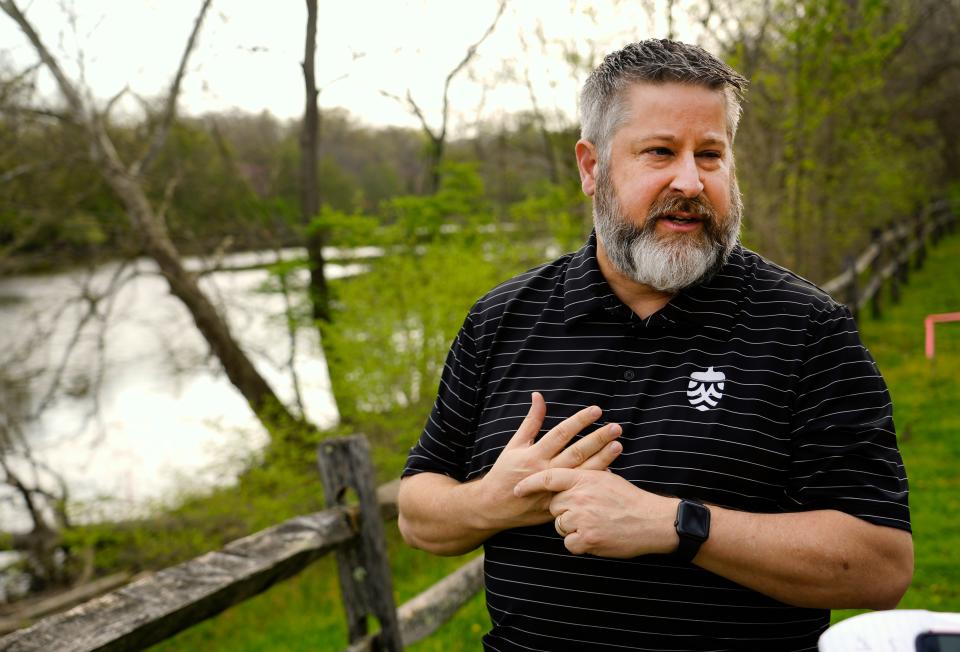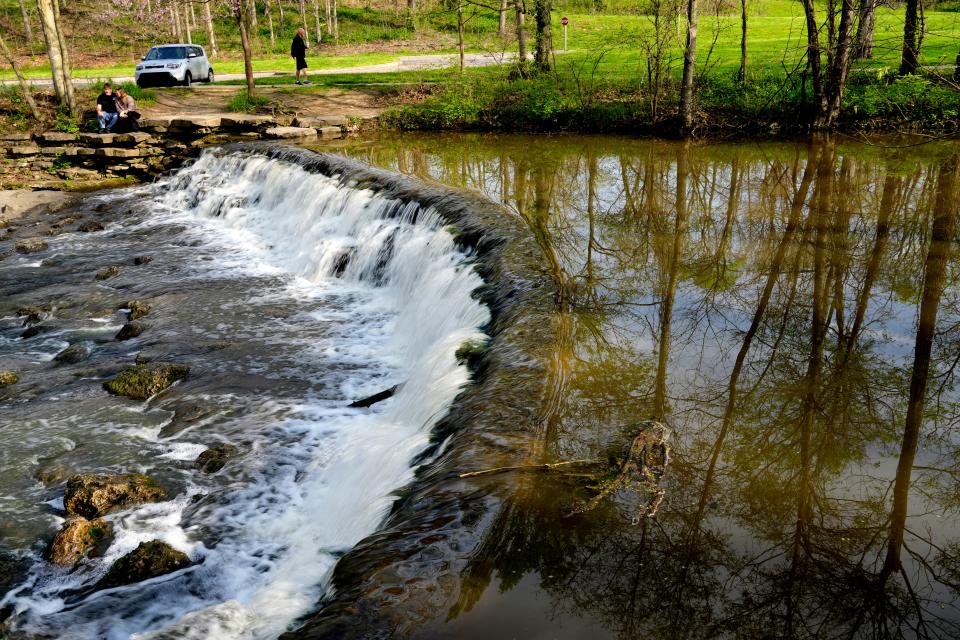How do you drain a lake? Here's how Sharon Lake will disappear and reappear

SHARONVILLE, Ohio – The plug has been pulled on Sharon Lake.
Around the clock, water on the 35-acre lake gushes out of an underwater pipe in a stone dam into Sharon Creek. It's all part of an $11.4 million restoration effort to dredge and ultimately preserve the popular fishing and boating destination in the heart of Sharon Woods park north of Cincinnati, officials with Great Parks of Hamilton County said.
Here's how and why the lake is being drained.
How do you drain a lake?
On April 3, workers with Prus Construction took a small, flat-bottomed boat out a few feet from the shore by the dam and climbed atop a stone box where two wheels sat.
One wheel turns the valve for an underground pipe that allows the water from the two creeks that feed into the lake to bypass the lake. This will ensure the streams won't fill the lake up again. The other valve releases the water from the lake into the first of two catch basins before it goes into Sharon Creek.
The workers turned the valves slightly, releasing the water slowly. Too fast, the Sharon Creek could flood.
How long will the draining take?
Water flows out of the lake 24 hours a day and will continue to do so for the next two months. A small bubbling below the dam is a sign of water leaking out.
The lake, which at its deepest is about 20 feet, had drained by 2.5 feet within the first two weeks. The shoreline had retreated by several feet, leaving a noticeable watermark around the edge. The entire lake will be dry by early June if all goes according to plan, said Todd Palmeter, chief executive officer of Great Parks of Hamilton County. That will depend on how much it rains over the next few months. Each rain naturally fills the lakebed.

Where does the water go?
The water will flow into Sharon Creek, which winds through Sharonville and empties into Mill Creek. The water eventually ends up in the Ohio River. The water is being let out gradually enough so residents won't notice much of a difference in the water levels of the creek, park district officials said.

What do workers do?
Workers every day check water levels, Palmeter said. If they feel the water is flowing too heavily into Sharon Creek, they will close the valve a little and reduce the flow. If the lake isn't draining fast enough, they will turn the wheel and open it a little wider.
"You don't want to open it wide open, and then you have rain, and then you're flooding," Palmeter said.
What happens when the lake is dry?
Workers will begin dredging and digging the excess silt from the lake bed. The crews will move the mud to the edge of the lake where it'll be used to create wetlands.
What will happen to the fish?
Some of the fish will escape through the valve into Sharon Creek. Others will perish. Birds of prey and other animals will dispose of the dead fish.
"There's going to be a loss of wildlife," Palmeter said. "It just happens when you have a project like this. However, bigger picture focus is we're making the lake better for future habitat."
Will I be able to walk on the lakebed?
You will not be able to walk on the lakebed. The soggy mud will be too dangerous and easy for any walker to get stuck, Palmeter said.

When will it open?
As of now, the project is expected to be finished and refilled by the end of 2025. It will take two months for the lake to refill naturally.
"We want the best wetland planting," Palmeter said. "We want the best waterfowl. We want the best amphibians. The way we're doing it will encourage all that to come back better than before."
Why is this project happening?
Decades of sediment have built up on the lake bottom, harming the ecosystem. In particular, the nutrients in the sediment have caused a plant called duckweed to grow rampant. Duckweed prevents sunlight and oxygen from reaching deeper levels of the lake, causing harm to fish and other plants, according to the park district.
What is Sharon Lake?
The man-made lake was created by damming Sharon Creek, part of a U.S. Works Progress Administration project in the 1930s to create a lake and park for recreation.
Has the lake been dredged before?
The lake was dredged once before, from 1986 to 1988.
Will it need to be dredged again?
The wetlands and infrastructure built as part of this project will prevent the lake from ever being dredged again, Great Parks officials said.
What will the project do?
Park officials will build a boardwalk, remove the excess sediment and use it to build wetlands, and put in a drainage system that will make future dredging unnecessary. To do this, the water needs to be removed.
This article originally appeared on Cincinnati Enquirer: How the park system is draining Sharon Lake

